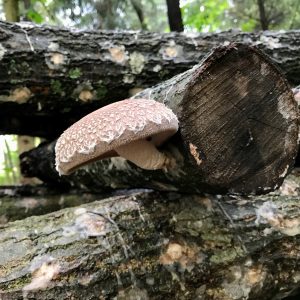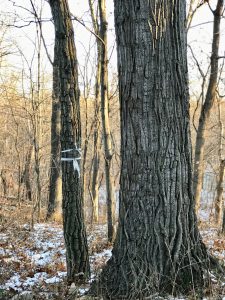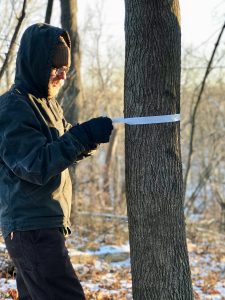
Shittake Mushroom
Many prefer to be indoors when it’s winter and bitter cold. Sitting by a fire, reading a book and having a glass of wine sounds perfect. This vision most likely does not include taking hikes along the forest’s edge and marking trees for growing mushrooms. But yet, that is what occurs on this farm during winter. If you want to produce mushrooms, this is a great time to identify trees as potential logs for fungi fruit projects. All you need for a similar adventure is a thermos of hot coffee and white plastic tape.
If you’re on the fence about growing mushrooms on logs, try it. You’ll be rewarded for 3 to 5 years with mushrooms after the initial sweat investment. The process is simple. You inoculate logs with spawn. Place finished logs in a woodland or shaded area. Then wait. You might have to water during dry spells and possibly cover your logs for winter protection. Then one day it finally happens, your first mushroom arrives, and you become a growing addict.
Trees need to be completely dormant before cutting into logs. Afterwards, you have a 2 to 3 week period to inoculate them with mushroom spawn. This process can occur anytime during fall, winter or early spring. But, planning is essential.
Last year we inoculated over 70 logs with Shiitake spawn. And surprisingly, we harvested our first mushrooms five months later. This amount exceeded our expectations. We now want to focus on expanding the farm’s fungi horizons by increasing our Shiitake logs and adding two new varieties. Ethan, who manages this project, has decided to include Oyster and Lions Mane mushrooms.
The planning process is not overly complicated. The steps include:
- Identify the mushrooms you want to grow.
- Select the right trees.
- Prepare your mushroom plot.
- Order your spawn and supplies.

Step One: Identify your Mushrooms
Before you know the type of trees to select, you first need to determine the varieties of mushrooms you desire to grow. Shiitake and Oyster mushrooms are easy to produce and will thrive in most regions. Both are great choices if you’re just starting out. We’re also adding Lions Mane to our list. It’s a beautiful medicinal mushroom with a light seafood taste.
 Step Two: Selecting Trees
Step Two: Selecting Trees
The next logical step is identifying the trees/logs, and tools necessary to get the job done. With Shiitake, we’ll use White Oak, Red Oak, Sugar Maple, Cherry and Ironwood logs. The Oyster mushrooms will grow on Basswood, Hackberry or Mulberry. We will also use Sugar Maple logs for Lions Mane.
The species of trees selected are readily available on our land. Your list will probably be different. Check out fungi.com for a handy cross-reference chart. There are many internet sites with information about tree species best for growing mushrooms.

Identifying Trees
Look for healthy trees, about 7 to 10 inches in diameter. We target undergrowth trees that are growing at an angle, or trees that should be cleared to help larger and straighter trees thrive. This process offers an extra benefit; you’ll be cleaning up your woodland areas at the same time. So, get your plastic marking tape and find a tree.
Step Three: Preparing Mushroom Plots
Finished logs inoculated with mushroom spawn need a plot in a secluded area, preferably in a wooded section. The desired place needs to offer plenty of shade and air circulation. When you have your space identified, you’ll need to clear an area for future stacking of completed logs. We place our finished logs on pallets for air flow.
Step Four: Order Spawn and Supplies
We purchase spawn and supplies from Field and Forest. With an exception to the pallets, you will be able to find all of your supplies. They also have helpful information and growing kits for beginners. We recommend the following tools:
- Mushroom spawn.
- Pallet(s). One pallet will hold 16 logs or more.
- Angle grinder adapter and a screw tip bit with a stop.
- Spring-loaded brass inoculator.
- Wax daubers.
- Cheese wax.

Inoculated Mushroom Logs
Next Steps for Innoculation
You can begin cutting your trees after you have all of your supplies. We prefer 36 to 40-inch logs. Any larger and they become difficult to handle. Finally, the steps of inserting the mushroom mycelium (spawn) can occur. We have detailed instructions for this process in our article “Log Grown Shiitake“, which are the same steps you can follow for Oyster mushrooms.
Growing mushrooms is an enjoyable and rewarding family project. And the best part, the flavour of homegrown mushrooms will exceed other fungi fruit available at the market.